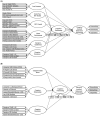Contributions of Disease Severity, Psychosocial Factors, and Cognition to Behavioral Functioning in US Youth Perinatally Exposed to HIV
- PMID: 27475941
- PMCID: PMC5280576
- DOI: 10.1007/s10461-016-1508-5
Contributions of Disease Severity, Psychosocial Factors, and Cognition to Behavioral Functioning in US Youth Perinatally Exposed to HIV
Erratum in
-
Erratum to: Contributions of Disease Severity, Psychosocial Factors, and Cognition to Behavioral Functioning in US Youth Perinatally Exposed to HIV.AIDS Behav. 2017 Sep;21(9):2716. doi: 10.1007/s10461-016-1518-3. AIDS Behav. 2017. PMID: 27568337 No abstract available.
Abstract
Among perinatally HIV-infected (PHIV) and perinatally HIV-exposed, uninfected (PHEU) youth, we evaluated the contributions of home environment, psychosocial, and demographic factors and, among PHIV only, HIV disease severity and antiretroviral treatment (ART), to cognitive functioning (CF) and behavioral functioning (BF). A structural equation modeling (SEM) approach was utilized. Exploratory factor analysis was used to reduce predictor variables to major latent factors. SEMs were developed to measure associations between the latent factors and CF and BF outcomes. Participants included 231 PHIV and 151 PHEU youth (mean age = 10.9 years) enrolled in the PHACS adolescent master protocol. Youth and caregivers completed assessments of CF, BF, psychosocial factors and HIV health. Medical data were also collected. Clusters of predictors were identified, establishing four parsimonious SEMs: child-assessed and caregiver-assessed BF in PHIV and PHEU youth. Among both groups, higher caregiver-child stress predicted worse BF. Caregiver resources and two disease severity variables, late presenter and better past HIV health, were significant predictors of CF in PHIV youth. Higher youth CF was associated with better caregiver-reported BF in both groups. Caregiver resources predicted caregiver-reported BF in PHEU youth, which was mediated via youth CF. Among PHIV youth, better past HIV health and caregiver resources mediated the effects of CF on caregiver-assessed BF. Using SEMs, we found a deleterious impact of caregiver and child stress on BF in both groups and of HIV disease factors on the CF of PHIV youth, reinforcing the importance of early comprehensive intervention to reduce risks for impairment.
Keywords: Antiretroviral therapy; Behavior; Cognition; HIV; Structural equation models; Youth.
Conflict of interest statement
Figures
Similar articles
-
Behavioral health risks in perinatally HIV-exposed youth: co-occurrence of sexual and drug use behavior, mental health problems, and nonadherence to antiretroviral treatment.AIDS Patient Care STDS. 2011 Jul;25(7):413-22. doi: 10.1089/apc.2011.0025. Epub 2011 May 5. AIDS Patient Care STDS. 2011. PMID: 21992620 Free PMC article.
-
Mental health functioning among children and adolescents with perinatal HIV infection and perinatal HIV exposure.AIDS Care. 2011 Dec;23(12):1533-44. doi: 10.1080/09540121.2011.575120. AIDS Care. 2011. PMID: 21702707 Free PMC article.
-
Executive Functioning in Children and Adolescents With Perinatal HIV Infection.Pediatr Infect Dis J. 2015 Sep;34(9):969-75. doi: 10.1097/INF.0000000000000809. Pediatr Infect Dis J. 2015. PMID: 26376309 Free PMC article.
-
Understanding the mental health of youth living with perinatal HIV infection: lessons learned and current challenges.J Int AIDS Soc. 2013 Jun 18;16(1):18593. doi: 10.7448/IAS.16.1.18593. J Int AIDS Soc. 2013. PMID: 23782478 Free PMC article. Review.
-
Cardiometabolic Complications in Youth With Perinatally Acquired HIV in the Era of Antiretroviral Therapy.Curr HIV/AIDS Rep. 2021 Oct;18(5):424-435. doi: 10.1007/s11904-021-00574-x. Epub 2021 Oct 15. Curr HIV/AIDS Rep. 2021. PMID: 34652624 Free PMC article. Review.
Cited by
-
Cumulative Psychosocial Risk is a Salient Predictor of Depressive Symptoms among Vertically HIV-Infected and HIV-Affected Adolescents at the Kenyan Coast.Ann Glob Health. 2017 Sep-Dec;83(5-6):743-752. doi: 10.1016/j.aogh.2017.10.024. Ann Glob Health. 2017. PMID: 29248090 Free PMC article.
-
Cognitive impairment in children and adolescents living with perinatal HIV disease in the ART era: a meta-analysis.EClinicalMedicine. 2024 Apr 23;72:102602. doi: 10.1016/j.eclinm.2024.102602. eCollection 2024 Jun. EClinicalMedicine. 2024. PMID: 39010974 Free PMC article.
-
"We did more than survive": lessons learned from studies of risk and resilience of young people growing up with HIV and mental health needs.AIDS Care. 2024 Jul;36(sup1):24-35. doi: 10.1080/09540121.2024.2308745. Epub 2024 Mar 6. AIDS Care. 2024. PMID: 38446048 Free PMC article.
-
Impact of Perinatally Acquired HIV Disease Upon Longitudinal Changes in Memory and Executive Functioning.J Acquir Immune Defic Syndr. 2017 Aug 1;75(4):455-464. doi: 10.1097/QAI.0000000000001441. J Acquir Immune Defic Syndr. 2017. PMID: 28481783 Free PMC article.
-
Trajectory Analysis of Cognitive Outcomes in Children With Perinatal HIV.Pediatr Infect Dis J. 2019 Oct;38(10):1038-1044. doi: 10.1097/INF.0000000000002427. Pediatr Infect Dis J. 2019. PMID: 31568142 Free PMC article. Clinical Trial.
References
-
- Smith R, Wilkins M. Perinatally acquired HIV infection: long-term neuropsychological consequences and challenges ahead. Child Neuropsychol. 2014;21:1–35. - PubMed
-
- Koekkoek S, de Sonneville LM, Wolfs TF, Licht R, Geelen SP. Neurocognitive function profile in HIV-infected school-age children. Eur J Paediatr Neurol. 2008;12(4):290–7. - PubMed
-
- Nichols S, Brummel SS, Smith RA, et al. Executive functioning in children and adolescents with perinatal HIV infection. [Accessed 9 Feb 2013];PIDJ. 2015 34:969–975. http://www.medscape.com/viewarticle/470017. - PMC - PubMed
MeSH terms
Grants and funding
LinkOut - more resources
Full Text Sources
Other Literature Sources
Medical
Miscellaneous


